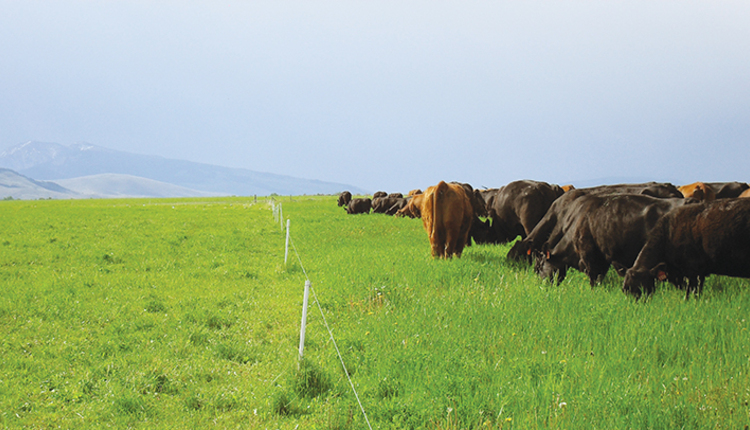What business are we really in? |
| By Jim Gerrish |
|
|
The author is a rancher, author, speaker, and consultant with over 40 years of experience in grazing management research, outreach, and practice. He has lived and grazed livestock in hot, humid Missouri and cold, dry Idaho.  Match stocking rates to seasonal carrying capacity. One of the most shocking statements for a group of ranchers to hear is when I tell them that ranching is really a land management business and that their livestock are just incidental to the process. We love our cows and tout their genetic superiority. We brag about calf weaning weights. We measure our success with stockers by average daily gain. Yet, with all this attention on our superior livestock, most ranches in the U.S. operate on the slimmest of margins with an average annual return on investment of less than 2%. What is missing from our business plans? What is missing is the understanding that most of the costs associated with ruminant livestock production are land-based costs, not per head costs. Almost all economic assessments of livestock operations find 50% to 80% of annual operating costs are feed related. For a ranch that operates completely on home-raised forage and feed, that automatically means 50% to 80% of operating costs are land related. It’s all about feed costs An assessment of Standardized Performance Appraisal (SPA) records by Allen Miller at University of Illinois several years ago found 57% of the variance in profitability across a broad spectrum of cow-calf operations was explained simply by the difference in feed costs. In the same analysis, calf weaning weight accounted for less than 5% of the variation in profit. Study after study over the last 20 years have shown there is virtually no relationship between calf weaning weight and profitability in the ranching business. The primary determinant of profitability in the cow-calf sector has repeatedly been shown to be feed costs. Where do all these feed costs come from? We buy or lease the land. In farming country, we sow seed, fertilize, and often mechanically harvest the feed and then deliver it to the livestock. We build a fence around acres. We build subdivision fences to make smaller units of acres. We put in ponds, wells, pipelines, and troughs all across our pasture or range acres. All of these are land-based costs. We need to shift our management focus away from improving individual performance to enhancing individual acre performance. In the Illinois study, equipment and facility depreciation was the second most influential parameter affecting profitability. What is most of the equipment on a ranch used for? Producing feed from the land. Most farms and ranches do not carry enough cattle to justify their investment in equipment. It takes a certain level of output per acre to pay for all that equipment. Increasing output per animal while running fewer and fewer animals on the land is rarely a paying proposition. If there is no difference in average weaning weight between the high-profit and low-profit ranches, we can conclude the livestock on the ranch are incidental to the business. What separates the high-profit ranches from low-profit ranches is how effectively they use their land resources. Too often, we make all these investments in creating productive pastures and then fail to utilize them effectively. Many places to look This premise ties together several of the concepts I have addressed in each of my Hay & Forage Grower columns from earlier this year. In my first column of the year, I explained how reducing the duration of each grazing period could improve annual forage utilization from 30% to 40% with set stocking to 70% to 90% with daily rotation in a productive environment. More grazing days harvested from every acre lowers feed costs. My second column dealt with the idea of matching stocking rate to seasonal carrying capacity to optimize livestock output per acre and individual animal performance. Carrying more animals enhances your revenue stream. More animal output per acre lowers feed costs. The third column addressed spring grazing management strategies to create more productive and higher quality pastures later in the summer. Better quality forage resulting in higher individual animal performance lowers feed cost. The fourth column addressed stockpiling winter feed and grazing more days during the dormant season to reduce the need for stored feeds. Mechanically harvested and stored forage almost always results in higher daily feed costs compared to grazing standing forage. More grazing days every year lowers feed costs. It is by increasing animal unit-days harvested from every acre (AUD/A) that we can radically change the profitability of cattle and sheep operations. The mainstream industry has spent most of the last 50 years focused on elevating individual animal performance — more milk per cow or ewe and heavier weaning weights. This has created larger cows and ewes with declining feed efficiency when placed out on landscapes where they must walk around daily to gather their feed and access water. The evidence is now overwhelming that there is an inverse relationship between cow size and whole ranch profitability . . . the larger the cow, the lower the profitability. This result is due largely to failing to understand that ruminant livestock production is really a land management business, and our focus needs to be on greater output and profit per acre, not on increasing output per animal. The livestock are only incidental to the business. This article appeared in the November 2020 issue of Hay & Forage Grower on page 20. Not a subscriber? Click to get the print magazine. |
